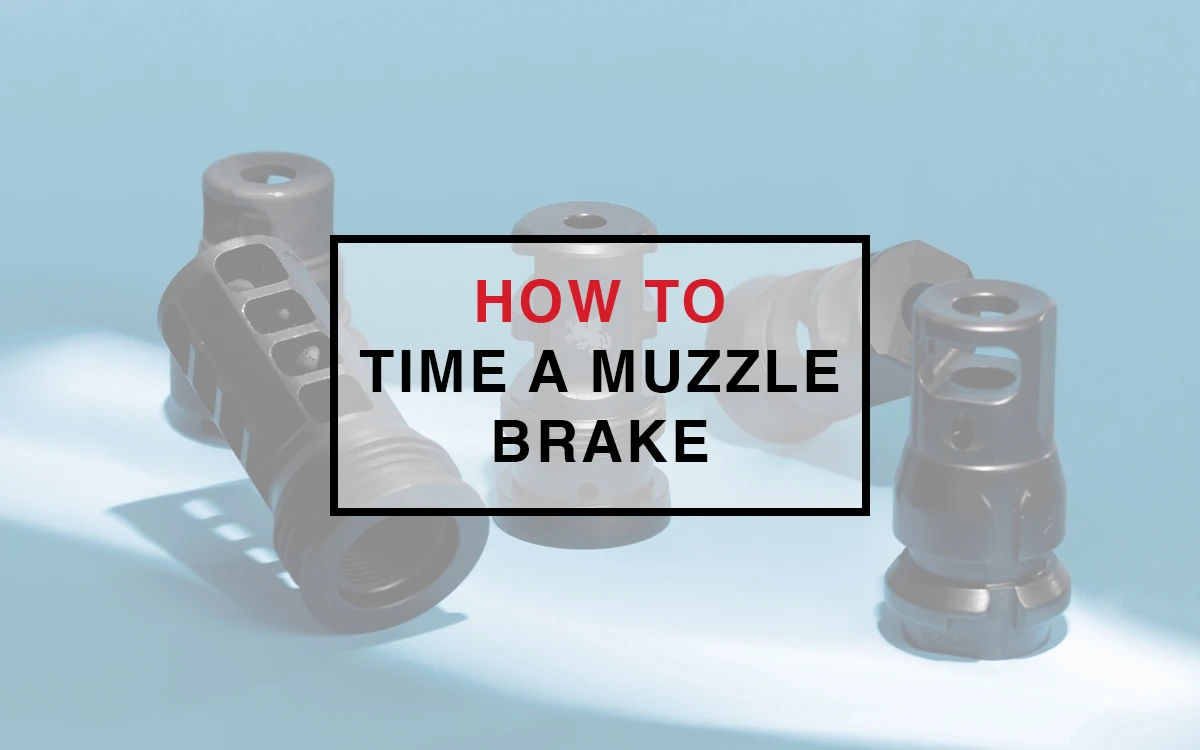

We get a lot of questions around how to time a muzzle brake (or really any muzzle device), as well as what timing even means. Another wrench in the matter is some folks refer to timing as indexing, kind of like the great silencer vs. suppressor debate. Indexing or timing your muzzle device can be incredibly important to your experience shooting. So we're here to give you all the details you need in order for your set up to be the best it can be.
Table of Contents
What does it mean to time a muzzle brake?
As you’ve already learned from the series, muzzle devices come in all shapes and sizes, with gas porting out of the device in different ways. Because of how some muzzle devices are designed, they may require a little extra TLC - especially muzzle brakes.
So, what does it mean to time a muzzle device? A muzzle brake is constructed with the intention of the primary ports of the gases to run side to side (as opposed to up and down, or no specific direction at all).
When you screw a muzzle brake onto a threaded barrel, the brake might not align properly for those ports to be horizontal. In order to make them line up correctly, you must use shims to time the device.
What are shims?
Shims are simply pieces of metal that are used specifically for correctly aligning a muzzle device. Some muzzle brakes come with a set of shims. Others, you have to buy your own (don’t worry, they’re easy to search for and find).
A package of shims comes with different thicknesses. So essentially you will use the shims to make sure that when you tighten down your muzzle device onto your barrel, the holes in the muzzle device are timed correctly for where you want the gases to flow when shooting.
If you’re not sure of the proper alignment, always refer to your user manual. That’s a sure fire way to make sure you’re doing something correctly.
Is there a difference between shims and crush washers?
There’s a HUGE difference between shims and crush washers. Crush washers, when “crushed” usually don’t evenly crush. This means that the muzzle brake might not be entirely concentric to the bore. With just a muzzle brake, a little misalignment might not be a big issue. But the more length you add onto a barrel and muzzle device (aka, adding a suppressor into the mix), the more “off” the projectile will be. This could lead to baffle or end cap strikes on the suppressor. It’s better to be safe than sorry and just always stick with shims.
Does every muzzle device have to be timed?
No, not every muzzle device needs to be timed. Some muzzle devices don’t require timing because the gas ports are evenly spaced apart.
That being said, while it isn’t required, sometimes it can be preferred. For example, the SureFire WarComp, as seen in the video, is a flash hider that has 3 evenly spaced prongs. The preferred spacing for flash hiders is to have a “top dead center” where one of the spacings is open at the top when the muzzle device is screwed on. Compared to muzzle brake, timing a flash hider isn’t as necessary, but it is recommended and preferred.
Also, those folks who only plan on using a suppressor on their firearm, may choose not to time their muzzle brake. Why? Because the brake is essentially acting as a sacrificial baffle and where the gases are ported isn’t as important because of the suppressor addition. That being said, if you ever choose to shoot without a suppressor, then you’d just be better off timing your muzzle brake from the beginning and not having to worry about it in the future.
How to time a muzzle brake.
- Grab your threaded barrel
- Screw your muzzle brake onto the barrel, and, using a torque wrench*, tighten to manufacturer specification
- Note the orientation of the muzzle brake compared to where you want it to be
- Unscrew the muzzle brake
- Add a shim and retighten on the muzzle brake
- Continue shim process until you have reached desired timing
- Finish tightening your muzzle brake fully using a torque wrench or a vise
*If you don’t have a torque wrench, we’d suggest getting one, but the less scientific way of doing this would be to eyeball and hand tighten. If you hand tighten and the brake is about ¼ of a turn until perfect, when you fully tighten, it should be around where you want it. If it is more than ¼ of a turn, you will want to add shims. Again, this isn’t entirely scientific, but it should help you get to where you need to go.
Conclusion
There you have it! The guide on how to time a muzzle brake and everything you might want to know about timing muzzle brakes. As always, if you have any questions, we’re only a chat box away.





